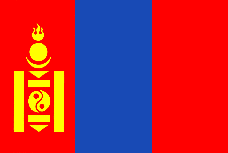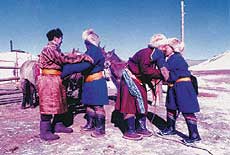Location: Northern Asia, between China and Russia
Geographis coordinates: 46 00N, 105 00E
Map references: Asia
Area: Total 1.565 million sq km
Climate: deserts, continental(large daily and seasonal temeprature ranges)
Terrain: vast semidesert and desert plains; mountains in the west southwest; Gobi Desert in southeast
Elevation extremes: lowest point-Hoh Nuur
highest point: Tavan Bogd Uul4,374m
Natural resources: oil, coal, copper, molybdenum, tungsten,
phosphates, tin, nickel, zinc, wolfram, flourspar, gold
 The name of the Mongolia has always stirred up visions of the untamed and exotic-the warlord Gehghis Khan, camels wandering in the Gobi Desert and wild horses galloping across the steppes. Even today, Mongolia seems like the end of the earth-outside Ulaan-Baatar you being to wonder if you have'nt stepped into another country. It remains one of the the last great adventure destination in Asia.
Mongolia survival as an independent nation is little short of miraculous, sandwiched as it is between the godzilla states of Russia and China. The country ruling democratic coalation but independent cost them dearly.
Luanguages: Mongolian, Turkic, Russian, Chinese
Religion: Tibetan Buddhism, Muslim, Shanism, Christian
Goverment:Communist REpublic
President: Bagabandi Natsag
Prime Minister: Enkhbayar Nambar
GDP: US $1billion
GDP per person: US $390
Annual growth: 3.5%
Inflation:44%
Major Trading Partners: Russia, China, Japan, US   TSAGAAN SAR, THE LUNAR NEW YEAR
By T.Enkhbold
According to Mongolian lunar calendar, the year 2000 is a year of an Iron Dragon.
Tsagaan Sar or White Month is one of Mongolia's two major and long-awaited holidays, the other being Naadam in July. For Mongols, Tsagaan Sar is not only an ancient holiday marking the end of winter and the beginning of a new year's cycle, but is also a time for unification and reinforcing social bonds.
Preparations for the festive start well ahead of time. Several families usually gather in the eldest man's gher (round, felt covered traditional dwelling), where the holiday will take place.
Since the holiday means all relatives, neighbors, friends and guests will be treated to a lavish meal, women make more than a thousand buuz and dumplings. Ready dumplings are lined on wooden plates and put outside. The next day, the frozen buuz are ready to be steamed. Families all across the country stock-up on food, diary products, mild milk vodka and other specialties for the occasion.
Bituun - last dinner of the outgoing year. bituun, meaning "to close down", takes place on the last day of the lunar month. Beforehand, all the business of the past year must be wrapped up; debts paid and good relationships restored.
"Our family began preparations almost one month ago," says D. Batdelger, a herder in Binder soum of Khentii province. "First of all, I repaired and cleaned out all the sheds, including the shelter for the cattle. And I've made a trip to town for New Year gifts and food supplies... Both my wife and I have had our hands full."
The hostess of the gher, Odiima, is bustling around the stove, cooking the New Year dinner.
"One is supposed to see in the New Year wearing all new clothes," she says. "So, this year I made new dels (national dress) for my husband, children, grandchildren, and myself.
"My daughter and I have made plenty of buuz and banshi (steamed meat dumplings and lamb patties) for the holiday as well as baking boov (biscuits). And yesterday, of course, we did a thorough cleaning so that on Tsagaan Sar there would not be a speck of dust in our gher."
The bituun evening is mainly celebrated in close family. In the evening, when all the family members gather, the women start to set the table. All guests straighten their clothes, put on their caps and take a seat around the table, according to their age and family hierarchy.
Date of Tsagaan Sar celebration
Lunar New Year, as in many Asian countries, calculated on a lunar calendar sometime between the end of January and start of March. But it often falls on the first new moon in February. Marks the start of the 'white' month; the name could originate from the white winter or milk dishes. But, by and large, Mongolians associate the color white with happiness and health.
And then bituun begins - the last dinner of the outgoing year. That evening, one must try all the dishes: boiled meat, a variety of milk products, meat dumplings and dessert... That means a long dinner late into the night. Usually airag (a mild beverage made of fermented mare's milk, often called "white beer"), mild vodka and tea with milk are served with the dinner.
Tradition states that before starting the meal, the host parts with the old year in a symbolic ceremony. Having placed a leg of lamb on his plate, he slices it and gives everyone a piece. Then he breaks the bone and draws out the marrow, thus symbolizing the opening of the New Year.
Dinner is lively: adults tell funny tales, sing and play with the children. Everyone has to feel cheerful and full of food, so that the family will also feel content in the next year. Even dogs are given extra bones to fill them up
|